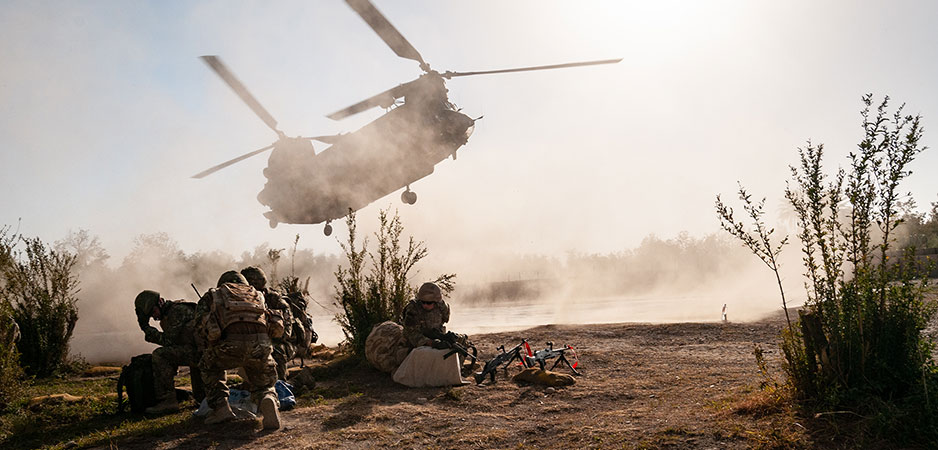Over the past three decades, the British Army has faced numerous challenges. British soldiers have been putting their lives on the line in several intense multilateral deployments, including the wars in Iraq and Afghanistan. These operations have enhanced the mechanical wear and tear, necessitating an early replacement of vehicles that were already due to be replaced by newer generations.
As bad luck would have it, the need for expensive new equipment comes at a time when budgets are scarce. In the wake of the disintegration of the Soviet Union, UK defense budget allocations were systematically slashed by governments that considered the expense no longer indispensable. This has led many observers to describe the modern British Army as a shadow of its former self. The entire British Armed Forces shrank by more than 50% percent over the past three decades, dropping from 311,000 to 145,000 personnel.
The Far Right Has a History of Infiltrating the British Army
While the overall budget has increased from £38 billion ($53 billion) to £48 billion, the figure is misleading as it does not take into account rising costs of development or inflation. A more telling indicator is the percentage of GDP dedicated to defense, which dropped from 3.5% to 1.7% between 1990 and 2020. The rhythm of deployments, however, has not slowed, with the UK taking an active part in virtually every NATO operation in the past decades.
But things may be changing. As defense expert Andrew Chuter writes: “The British government has approved the largest rise in its defense budget since the end of the Cold War, with £16.5 billion (U.S. $21.9 billion) in additional funding made available for spending on shipbuilding, space, cyber, research and other sectors over a four-year period.” This is welcome news for an institution that can no longer count on European military assistance as it could before Brexit.
Retiring the Heavy Cavalry
In the coming decade, Britain will be waving its Challenger 2 tanks goodbye. Put in service at the end of the 20th century, the Challenger has served proudly in Iraq, Kosovo and Bosnia. The 2003 invasion of Iraq was simultaneously its finest hour and the beginning of the end for the heavy tank. During combat, Challengers were repeatedly struck with rocket-propelled grenades and proved exceptionally robust. Throughout the invasion, the tank remained operational despite extreme conditions and performed admirably.
However, it became apparent that the Challenger could only be deployed in certain environments. Challengers were never used in Afghanistan because they could hardly have operated in the mountainous terrain and because this battlefield was landlocked — two factors that threaten the tanks’ very existence. Heavy armor can be moved easily by sea, with difficulty over land and never by air.
The heavy tanks are, therefore, proving increasingly irrelevant as Britain strives to maintain its global presence and capacity. From a strategic setting that pitched two massive conventional military blocs against each other in the plains of Central Europe, the West discovered a post-Cold-War era in which it needed to be able to deploy rapidly to every corner of the world. Heavy weaponry is considerably less relevant today. This type of firepower is not needed in skirmishes and territory control, and its low deployability presents a problem for many operations.
As the UK Ministry of Defense struggles to reorganize budgets, it surprises no one that heavy armor would be the first on the list for the difficult cuts ahead. After several drops in numbers, Harry Lye reports that “The British Army’s fleet of Challenger 2 main battle tanks (MBTs) and Warrior Armoured Fighting Vehicles (AFVs) could be cut under plans reportedly being drawn up by military chiefs.” What will replace British armor if it is effectively mothballed is anyone’s guess.
The Artillery
Britain’s AS-90s are also getting close to retirement and, for once, this may be good news. The AS-90 is the UK’s standard self-propelled artillery — effectively a tank, mounted with an artillery howitzer instead of a direct-fire barrel. Artillery regiments have also seen their fleets diminished, for the same budget reasons, and they are also plagued with the same logistical difficulties as their colleagues in the heavy-armor divisions. While not quite as heavy, AS-90 howitzers are immensely cumbersome due to their armor coating, are nearly impossible to move quickly and will easily be evaded by today’s nimble insurgencies.
But Britain is in luck: There is a new type of howitzer on the market that may fix all of the army’s problems at once. New truck-mounted howitzers, such as the French Caesar cannon, swap armor for mobility. Their simpler design makes them easily transportable by air and considerably less expensive than their predecessors. The Caesar howitzer is the first of its kind to have successfully passed the test by fire in operational deployments. Magzter reports that “Using the truck’s ability to move offers the benefit of being able to have a much lower total system weight particularly if armour protection is either limited to the driver/crew cab area or even eliminated altogether.”
China, France, Japan, Sweden and many others all have turned to this design, which has demonstrated good operational results. The Caesar cannon is also one of the few artillery types that are air-transportable. Should Britain acquire such howitzers, it could simultaneously maintain its current stock numbers and reduce its military expenditure — a rare opportunity in military affairs.
The Caesar artillery unit also represents a diplomatic opportunity. The UK was hoping that Brexit would naturally lead to closer ties with the US. This has not transpired — and seems unlikely in the future. Plans for an integrated EU army and low financial contributions from Western European countries have led to American exasperation with its Eastern allies, meaning that US strategies have become, in reaction, increasingly self-sustained and self-centered over the years. Building reinforced interoperability with the French and enhancing the capacity among European nations for rapid deployment is a practical and achievable way to rebuild international ties.
The Boxer Gamble
And then, of course, there was the Boxer, the now-infamous infantry fighting vehicle which, despite its critical role on the battlefield, was purchased under the worst possible conditions. While the protection of infantry soldiers receives priority, now that new threats are about, it is unclear why London would allow fair competition for the tender to be scrapped.
Soldiers commonly need to take the threat of improvised explosive devices or drones into account — something that hardly existed in the 20th century. But, given how drastically the battlefield has changed in the past few decades, defense analysts were astounded that the British Army would throw as fundamental a quality prerequisite as a tender out of the window. By a simple decision, the UK bought the Boxer off the shelf, hoping that it would somehow be adapted to modern threats. Andrew Chuter covered the matter, indicating that 500 Boxers would be ordered — without competition — from the defense contractor Artec at a cost of £4.4 billion, to be delivered in 2023.
The price tag includes 10 years of technical support. This entails that in case the Boxer reveals itself ill-suited to current-day operations, the UK troops will be stuck with it for at least a decade. Hasty and unverified spending is certainly unwelcome in times of financial strain. But what is done is done. The British Army will presumably not be overturning this decision, and we can hope the Boxer performs well.
Some of the choices facing the British Army will not make commanders’ hair turn gray beyond reason. If new cannons come at a lower cost, the army can stay within its budgetary envelope and maintain, or even increase, its fleet. Other choices, such as deciding whether to shelve the cavalry, will be more of a strategic gamble. Indeed, Britain may have little need for heavy tanks now, but who knows if it will need them again? One thing is sure, however: Buying the Boxer blindfolded was a huge, almost irresponsible risk in a time of budgetary constraints. Let’s hope future choices will be made with more discernment.



